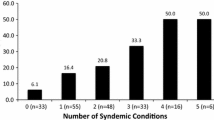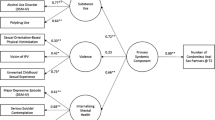Abstract
Research shows that young men who have sex with men (YMSM) engage in higher rates of health risk behaviors and experience higher rates of negative health outcomes than their peers. The purpose of this study is to determine if the effects of adversity on HIV risk are mediated by syndemics (co-occurring health problems). Participants were 470 ethnically diverse YMSM ages 18 to 24 recruited between 2005 and 2006 and surveyed every 6 months for 24 months. Regression analyses examined the impact of adversity on syndemics (emotional distress, substance use, and problematic alcohol use) and the effects of both adversity and syndemics on HIV risk behaviors over time. Gay-related discrimination and victimization—among other adversity variables—were significantly associated with syndemics and condomless sex (CS). Syndemics mediated the effects of adversity on CS in all models. Adverse events impact HIV risk taking among YMSM through syndemics. These findings suggest that prevention programs aimed at reducing adversity may reduce both the synergistic effect of multiple psychosocial health problems and HIV risk taking.

Similar content being viewed by others
References
Herrick A, Marshal MP, Smith HA, Sucato G, Stall R: sex While intoxicated: a meta-analysis comparing heterosexual and sexual minority youth. J Adolesc Health. 2010, [Epub ahead of print].
Marshal MP, Friedman MS, Stall R, et al. Sexual orientation and adolescent substance use: a meta-analysis and methodological review. Addiction. 2008; 103: 546–556.
Friedman MS, Marshal MP, Guadamuz TE, et al. A meta-analysis of disparities in childhood sexual abuse, parental physical abuse, and peer victimization among sexual minority and sexual nonminority individuals. Am J Public Health. 2011; 101(8): 1481–94.
Singer M, Clair S. Syndemics and public health: reconceptualizing disease in bio social context. Med Anthropol Q. 2003; 17: 423–441.
CDC: http://www.cdc.gov/syndemics/. Retrieved July, 2009 from http://www.cdc.gov/syndemics/
Mustanski B, Garofalo R, Herrick A, Donenberg G. Psychosocial health problems increase risk for HIV among urban young men who have sex with men: preliminary evidence of a syndemic in need of attention. Ann Behav Med. 2007; 34: 37–45.
Stall R, Mills TC, Williamson J, et al. Association of co-occurring psychosocial health problems and increased vulnerability to HIV/AIDS among urban men who have sex with men. Am J Public Health. 2003; 93: 939–942.
Solomon TM, Halkitis PN, Moeller RM, et al. Sex Parties among young gay, bisexual, and other men who have sex with men in New York City: attendance and behavior. J Urban Health. 2011; 88(6); 1063.
Kurtz SP. Arrest histories of high-risk gay and bisexual men in Miami: unexpected additional evidence for syndemic theory. J Psychoactive Drugs. 2008; 40: 513–521.
McCarthy K, Wimonsate W, Guadamuz T, et al. Syndemic analysis of co - occurring psychosocial health conditions and HIV infection in a cohort of men who have sex with men (MSM) in Bangkok, Thailand. Vienna: International AIDS Conference; 2010.
Friedman MS, Marshal MP, Guadamuz TE, et al. A meta-analysis of disparities in childhood sexual abuse, parental physical abuse, and peer victimization among sexual minority and sexual nonminority individuals. Am J Public Health. 2011; 101: 1481.
Herrick AL, Lim SH, Plankey MW, et al. Adversity and syndemic production among men participating in the multicenter AIDS cohort study: a life-course approach. Am J Public Health. 2013; 103(1): 79–85.
Stall R, Friedman M, Catania J: Interacting epidemics and gay men’s health: a theory of syndemic production among urban gay men. In: Wolitski R, Stall R, Valdiserri R, editors. Unequal Opportunity: Health Disparities Affecting Gay and Bisexual Men in the United States. Oxford: Oxford University Press; 2007. p. 251–274.
Meyer IH. Prejudice, social stress, and mental health in lesbian, gay, and bisexual populations: conceptual issues and research evidence. Psychol Bull. 2003; 129: 674–697.
Kurasaki KS, Okazaki S, Sue S. Asian American mental health: assessment theories and methods. New York, NY : Kluwer Academic/Plenum Publishers; 2002.
Mezzich JE, Caracci G. Cultural formulation: a reader for psychiatric diagnosis. Lanham, MD: Jason Aronson; 2008.
Peterson DB. Psychological aspects of functioning, disability, and health. New York, NY: Springer Pub; 2011.
Puri BK. Saunders’ pocket essentials of psychiatry. 2nd ed. Edinburgh, UK: W.B. Saunders; 2000.
Rosario M, Schrimshaw EW, Hunter J. A model of sexual risk behaviors among young gay and bisexual men: longitudinal associations of mental health, substance abuse, sexual abuse, and the coming-out process. AIDS Educ Prev. 2006; 18: 444–460.
Kipke MD, Kubicek K, Weiss G, et al. The health and health behaviors of young men who have sex with men. J Adolesc Health. 2007; 40: 342–350.
Kipke MD, Weiss G, Ramirez M, et al. Club drug use in Los Angeles among young men who have sex with men. Subst Use Misuse. 2007; 42: 1723–1743.
Wong CF, Kipke MD, Weiss G, McDavitt B: The impact of recent stressful experiences on HIV-risk related behaviors. J Adolesc. 2009.
Muhib FB, Lin LS, Stueve A, et al. A venue-based method for sampling hard-to-reach populations. Public Health Rep. 2001; 116: 216.
Diaz RM, Ayala G, Bein E, Henne J, Marin BV. The impact of homophobia, poverty, and racism on the mental health of gay and bisexual Latino men: findings from 3 US cities. Am J Public Health. 2001; 91: 927–932.
Nott K, Vedhara K, Power M. The role of social support in HIV infection. Psychol Med. 1995; 25: 971–983.
Radloff LS. The Ces-D scale. Appl Psychol Meas. 1977; 1: 385.
Ostrow DG, Monjan A, Joseph J, et al. HIV-related symptoms and psychological functioning in a cohort of homosexual men. Am J Psychiatry. 1989; 146: 737–742.
McNall M, Remafedi G. Relationship of amphetamine and other substance use to unprotected intercourse among young men who have sex with men. Arch Pediatr Adolesc Med. 1999; 153: 1130–1135.
Hayes A. Beyond Baron and Kenny: statistical mediation analysis in the new millennium. Commun Monogr. 2009; 76: 408–420.
Preacher KJ, Hayes AF. SPSS and SAS procedures for estimating indirect effects in simple mediation models. Behav Res Methods Instrum Comput. 2004; 36: 717–731.
MacKinnon DP, Lockwood CM, Williams J. Confidence limits for the indirect effect: distribution of the product and resampling methods. Multivar Behav Res. 2004; 39: 99.
Williams J, Mackinnon DP. Resampling and distribution of the product methods for testing indirect effects in complex models. Struct Equ Model. 2008; 15: 23–51.
Kissinger P, Rice J, Farley T, et al. Application of computer-assisted interviews to sexual behavior research. Am J Epidemiol. 1999; 149: 950–954.
Morrison-Beedy D, Carey MP, Tu X. Accuracy of audio computer-assisted self-interviewing (ACASI) and self-administered questionnaires for the assessment of sexual behavior. AIDS Behav. 2006; 10: 541–552.
Muhib FB, Lin LS, Stueve A, et al. A venue-based method for sampling hard-to-reach populations. Public Health Rep. 2001; 116: 216.
Stueve A, O’Donnell LN, Duran R, San Doval A, Blome J. Time-space sampling in minority communities: results with young Latino men who have sex with men. Am J Public Health. 2001; 91: 922–926.
Newcomb ME, Mustanski B: Moderators of the relationship between internalized homophobia and risky sexual behavior in men who have sex with men: a meta-analysis. Arch Sex Behav. 2009:1-11.
Acknowledgments
Support for this study was provided by the National Institute of Drug Abuse (R01 DA015638-03) and by the National Institute of Mental Health (1 F31 MH087238-01A1). We thank the HYM study team and the PITT Public Health Behavioral HIV team for their contribution to this study. Most importantly, we would sincerely like to thank the young men who have participated for their immense contribution to HIV research.
Author information
Authors and Affiliations
Corresponding author
Rights and permissions
About this article
Cite this article
Herrick, A., Stall, R., Egan, J. et al. Pathways towards Risk: Syndemic Conditions Mediate the Effect of Adversity on HIV Risk Behaviors among Young Men Who Have Sex with Men (YMSM). J Urban Health 91, 969–982 (2014). https://doi.org/10.1007/s11524-014-9896-1
Published:
Issue Date:
DOI: https://doi.org/10.1007/s11524-014-9896-1




